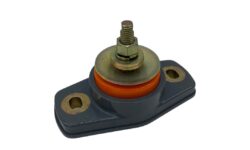Water Pressure Reducing Valve: Controlling Water Flow for Better Plumbing Performance
Water pressure is a crucial aspect of any plumbing system, impacting its overall performance and efficiency. When the water pressure is too high or too low, it can lead to a range of problems, including leaky pipes, damaged appliances, and even potential safety hazards. To address these issues, a Water Pressure Reducing Valve (WPRV) comes to the rescue.
Understanding Water Pressure
- The Importance of Proper Water Pressure: Maintaining the right water pressure is essential for a smooth plumbing experience. Adequate pressure ensures that water flows efficiently through the pipes, allowing household fixtures and appliances to function optimally.
- The Impact of High Water Pressure: High water pressure can cause undue stress on pipes and fixtures. The constant strain may lead to leaks, bursts, and premature wear and tear, resulting in costly repairs and wastage of water.
- The Consequences of Low Water Pressure: On the other hand, low water pressure can be equally problematic. It leads to slow water flow, causing inconvenience when performing daily tasks such as showering, washing dishes, or watering the garden.
What is a Water Pressure Reducing Valve (WPRV)?
A Water Pressure Reducing Valve, commonly known as a pressure regulator, is a device designed to control and reduce the water pressure coming into a building from the main water supply. It acts as a gatekeeper, ensuring that the water pressure remains within safe and optimal levels.
How Does a WPRV Work?
The WPRV operates based on a simple principle. It contains an adjustable spring-loaded diaphragm that responds to changes in water pressure. When the incoming pressure exceeds the desired level, the valve reduces the flow of water to maintain the preset pressure.
Key Components of a WPRV
A typical WPRV consists of four main components: the body, diaphragm, spring, and adjustment screw. These elements work together to regulate the water pressure effectively.
Signs You Need a Water Pressure Reducing Valve
To determine if you need a WPRV, watch out for the following signs of water pressure issues:
- Water Hammering: Water hammering is a loud banging noise that occurs when water suddenly stops or changes direction in the pipes. It can cause pipe damage and should be addressed promptly.
- Constant Leaks: Frequent leaks in your plumbing system may be a result of high water pressure. Repairing these leaks can become a recurring and costly problem.
- Damaged Appliances: Appliances like washing machines and dishwashers are susceptible to damage from excessive water pressure, leading to a shortened lifespan.
Selecting the Right Water Pressure Reducing Valve
Choosing the appropriate WPRV for your home requires careful consideration of various factors.
- Assessing Your Water Pressure: Start by measuring your water pressure to determine if you indeed need a WPRV. A simple pressure gauge can help you with this task.
- Sizing and Capacity Considerations: Make sure to select a WPRV that can handle the maximum flow rate of water required in your household.
- Material and Durability: Opt for a WPRV made from high-quality materials to ensure durability and longevity.
- Pressure Adjustment Range: Look for a WPRV that allows you to adjust the water pressure to meet your specific needs.
Maintenance of a Water Pressure Reducing Valve
Regular maintenance is essential to keep your WPRV in top condition.
- Regular Inspection: Periodically inspect the WPRV for any signs of damage or wear. Address any problems as soon as possible to avoid further damage.
- Cleaning and Lubrication: Clean the valve and its components regularly to remove debris and sediment. Lubricate the working parts to ensure that they run smoothly.
- Replacing Faulty Components: If any part of the WPRV is damaged or malfunctioning, replace it immediately to maintain the valve’s effectiveness.
Benefits of Using a Water Pressure Reducing Valve
Investing in a WPRV offers several advantages for your plumbing system and household.
- Protecting Plumbing System: By regulating the water pressure, the WPRV reduces strain on pipes and fixtures, minimizing the risk of leaks and bursts.
- Energy and Water Savings: Optimal water pressure leads to reduced water usage, resulting in lower energy bills and conservation of water resources.
- Extending Appliance Lifespan: With balanced water pressure, appliances like washing machines and dishwashers operate efficiently and have a longer lifespan.
Common Misconceptions about Water Pressure Reducing Valves
Addressing some common misconceptions can help you better understand the role of WPRVs.
- WPRVs Reduce Water Flow: While WPRVs lower the water pressure to safe levels, they do not significantly reduce water flow when correctly sized and adjusted.
- WPRVs Are Only for Commercial Buildings: WPRVs are equally essential for residential properties, ensuring plumbing system longevity and efficient water usage.
- WPRVs Solve All Plumbing Problems: While WPRVs are beneficial. They cannot fix underlying plumbing issues, such as clogs or damaged pipes.
Troubleshooting Water Pressure Issues
If you encounter water pressure problems, follow these troubleshooting steps.
- Identifying the Source of Problems: Determine if the issue is related to the water supply, the WPRV, or other plumbing components.
- DIY Fixes for Minor Issues: For minor water pressure issues, you can try cleaning the faucet aerators or showerheads to improve flow.
- When to Call a Professional: If the water pressure problem persists or seems more complex, it’s best to seek assistance from a professional plumber.
Conclusion
A water pressure reducing valve is a valuable addition to any plumbing system. Controlling water pressure safeguards your pipes, and appliances, and reduces water waste. When choosing a WPRV, consider your home’s specific needs, and don’t forget regular maintenance to keep it functioning optimally. By investing in a WPRV, you’ll enjoy better plumbing performance, lower utility bills, and enhanced appliance longevity.



